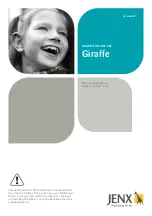
TRAVELER 4all Ergo & 4you Ergo usage instructions
11
14 Safety instructions regarding
obstacles
Driving on steps with the product is for-
bidden.
Due to the significantly high risk of tipping
and injury, the product should only be used to
negotiate escalators after participation in a
corresponding safety training course and with
an accompanying person for safety reasons.
The maximum obstacle height that can be
negotiated is 10 cm.
Obstacles like curbs, for example, should
always be negotiated driving forwards and
always using the minimum speed required.
When driving over or passing obstacles, it
is important that you avoid any product or body
parts catching on the obstacle as this may lead
to falls causing serious injuries to the user and
third parties as well as damage to the product.
Always drive over curbs or other obsta-
cles so that you cross them to the front or at
right angles. When approaching an obstacle at
an angle or driving over it with just one drive
wheel, there is an increased risk of tipping over
sideways.
If the product with the user needs to be
transported over an obstacle and there are
suitable facilities such as a ramp or a lift avail-
able, then these should be used. If such facili-
ties are not available, then the obstacle is to be
overcome by being carried by two helpers.
When carrying the product, it may not
be lifted
by the side sections, the drive wheels or the
footrests. We recommend holding the product
on the frame and back cross bar.
Before crossing an obstacle (steps,
thresholds, etc.), the anti-tipping supports must
be swivelled from the operating to the passive
position so that you do not make contact with
the obstacle when crossing, which could cause
you to fall. After crossing the obstacle, the anti-
tipping supports must be immediately returned
to the operating position (Chapter 25.1).
For overcoming obstacles such as kerbs
or steps, the product needs to be actively
tipped. The caster wheel may otherwise jam at
right angles to the obstacle and could block.
This could damage the caster wheel or the
caster fork and result in injury to the user. If
actively tipping it is not possible, then the ob-
stacle should not be approached or you need
to request assistance from an accompanying
person. Particular attention needs to be paid to
this when using an auxiliary drive.
15 Safety instructions regarding
dangerous locations and dan-
gerous situations
The operator of the product determines the
route to be driven themselves, taking the us-
age instructions, their driving knowledge, and
physical abilities into consideration.
The user’s individual handling skills are par-
ticularly important in the following dangerous
locations that are provided as examples; the
user must use their judgement before tackling
such locations in their wheelchair:
quay walls, jetties and piers, paths and
locations close to bodies of water, unse-
cured bridges and dykes.
narrow paths, slopes (e.g. ramps and
driveways), narrow paths on a slope,
mountainous routes.
narrow and/or steeply sloping paths along
main roads or near cliffs.
routes that are covered in leaves, snow
or ice.
ramps and lifting equipment on vehicles.
When cornering or turning on hills or
downward slopes, there may be an increased
tendency to tip over to the side due to the
changes in the centre of gravity. Avoid such
driving manoeuvres. If these manoeuvres can-
not be avoided, perform them with increased
caution and only at slow speed. In some cas-













































